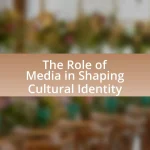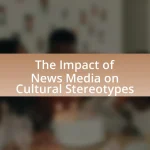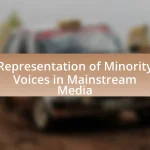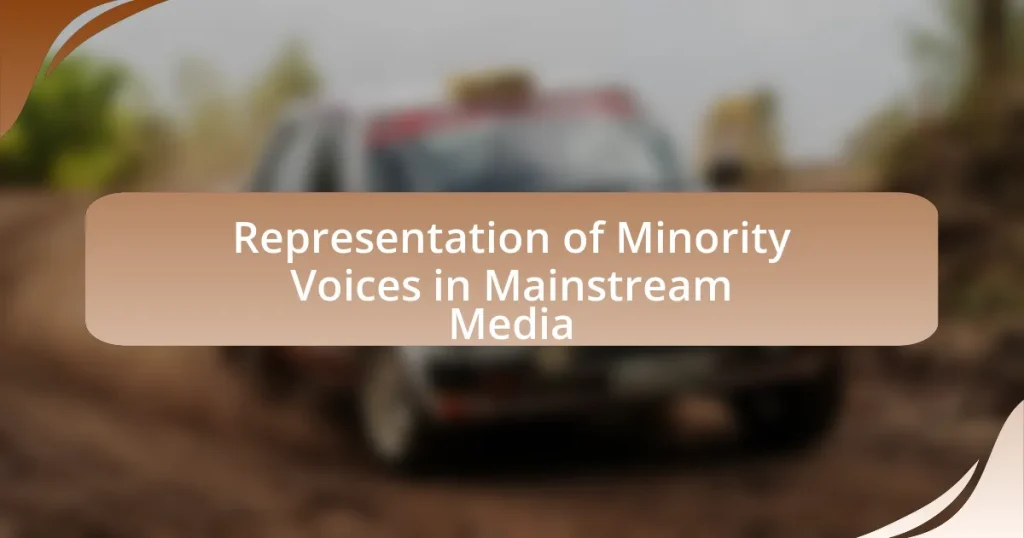The article examines the representation of minority voices in mainstream media, highlighting the significant underrepresentation and stereotypical portrayals of racial and ethnic minorities, LGBTQ+ individuals, and people with disabilities. It discusses the importance of accurate representation in fostering inclusivity, challenging stereotypes, and shaping societal perceptions. Current trends indicate a shift towards increased visibility and authenticity, influenced by movements such as Black Lives Matter and #MeToo. The article also addresses the barriers minority voices face in gaining representation, the impact of audience perceptions, and practical steps for improving diversity in media content.
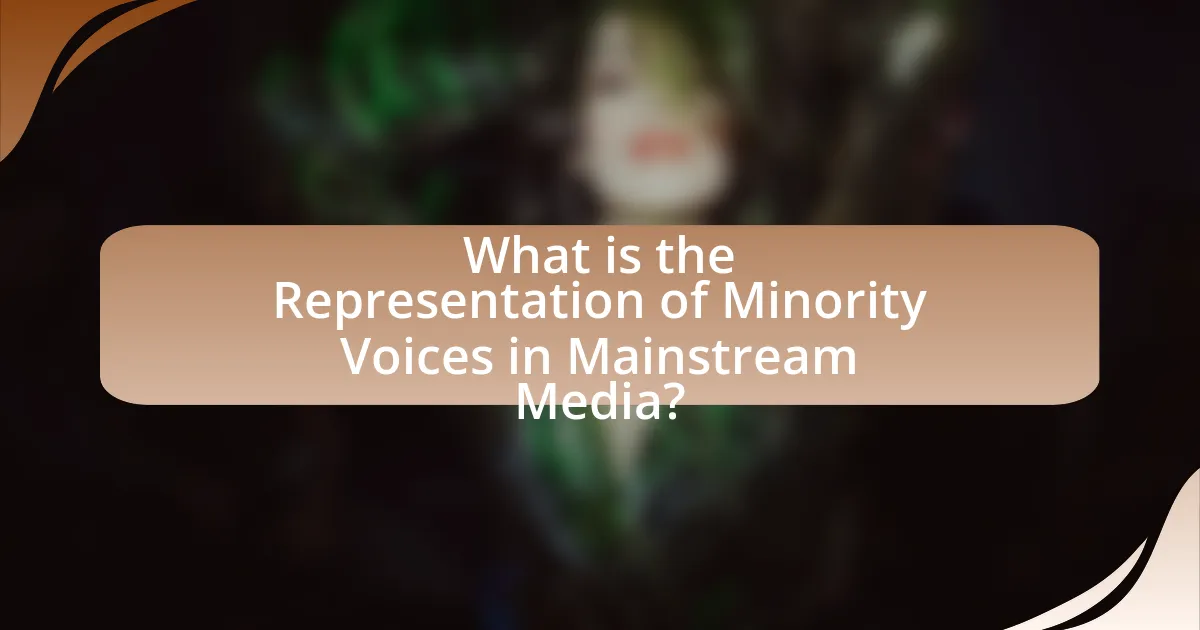
What is the Representation of Minority Voices in Mainstream Media?
The representation of minority voices in mainstream media is often limited and stereotypical, leading to a lack of authentic narratives. Studies indicate that minority groups, such as racial and ethnic minorities, LGBTQ+ individuals, and people with disabilities, are underrepresented in key media roles and storylines. For instance, a 2020 report by the USC Annenberg Inclusion Initiative found that only 28.3% of characters in popular films were from underrepresented racial and ethnic groups. This underrepresentation can perpetuate harmful stereotypes and fail to reflect the diversity of society, impacting public perception and understanding of these communities.
Why is the representation of minority voices important in media?
The representation of minority voices in media is crucial because it fosters inclusivity and reflects the diversity of society. When media accurately portrays minority groups, it challenges stereotypes and promotes understanding, which can lead to greater social cohesion. Research indicates that diverse representation can positively influence public perception and reduce prejudice; for instance, a study by the American Psychological Association found that exposure to diverse media representations can enhance empathy and reduce bias towards marginalized communities. Thus, the inclusion of minority voices in media not only enriches storytelling but also plays a vital role in shaping societal attitudes and promoting equality.
How does representation impact societal perceptions of minorities?
Representation significantly impacts societal perceptions of minorities by shaping public understanding and attitudes towards these groups. When minorities are accurately and positively represented in mainstream media, it can lead to greater acceptance and reduced stereotypes, as evidenced by studies showing that diverse portrayals foster empathy and understanding among audiences. For instance, a report by the Geena Davis Institute on Gender in Media found that increased representation of women and minorities in film correlates with improved perceptions and attitudes towards these groups among viewers. Conversely, negative or stereotypical portrayals can reinforce biases and perpetuate discrimination, highlighting the critical role that representation plays in influencing societal views.
What role does media play in shaping cultural narratives?
Media plays a crucial role in shaping cultural narratives by influencing public perception and understanding of various social issues. Through the selection of stories, framing of events, and portrayal of characters, media can reinforce or challenge existing cultural norms and values. For instance, studies have shown that representation in media affects audience attitudes; a report by the Geena Davis Institute on Gender in Media found that increased visibility of female characters in films correlates with greater acceptance of gender equality among viewers. This demonstrates that media not only reflects cultural narratives but actively participates in their construction and evolution.
What are the current trends in the representation of minority voices?
Current trends in the representation of minority voices include increased visibility and authenticity in mainstream media. This shift is evidenced by the rise of diverse storytelling, where platforms like Netflix and Hulu prioritize content created by and featuring minority groups, reflecting their experiences and perspectives. For instance, the success of shows like “Pose,” which centers on the LGBTQ+ community of color, highlights the demand for authentic narratives. Additionally, data from the 2021 Hollywood Diversity Report indicates that films with diverse casts perform better at the box office, reinforcing the importance of representation in attracting wider audiences.
How have recent movements influenced media representation?
Recent movements, such as Black Lives Matter and #MeToo, have significantly influenced media representation by increasing visibility and authenticity of minority voices. These movements have prompted media outlets to prioritize diverse storytelling and representation, leading to a rise in content that reflects the experiences and perspectives of marginalized communities. For instance, the success of films like “Black Panther” and “Crazy Rich Asians” demonstrates a shift in Hollywood towards inclusive narratives, resulting in higher box office revenues and critical acclaim. Additionally, studies indicate that audiences are more engaged with media that authentically represents their identities, further validating the impact of these movements on media practices.
What statistics reflect the current state of minority representation in media?
As of 2023, minority representation in media remains disproportionately low, with people of color comprising only 27% of lead roles in film and television, despite making up over 40% of the U.S. population. A report from the USC Annenberg Inclusion Initiative highlights that in 2021, only 16% of directors were from underrepresented racial and ethnic groups. Furthermore, the 2022 Hollywood Diversity Report indicates that while there has been some progress, Black, Indigenous, and People of Color (BIPOC) still face significant barriers, with only 12% of film leads being Black and 5% being Asian. These statistics underscore the ongoing challenges in achieving equitable representation in mainstream media.
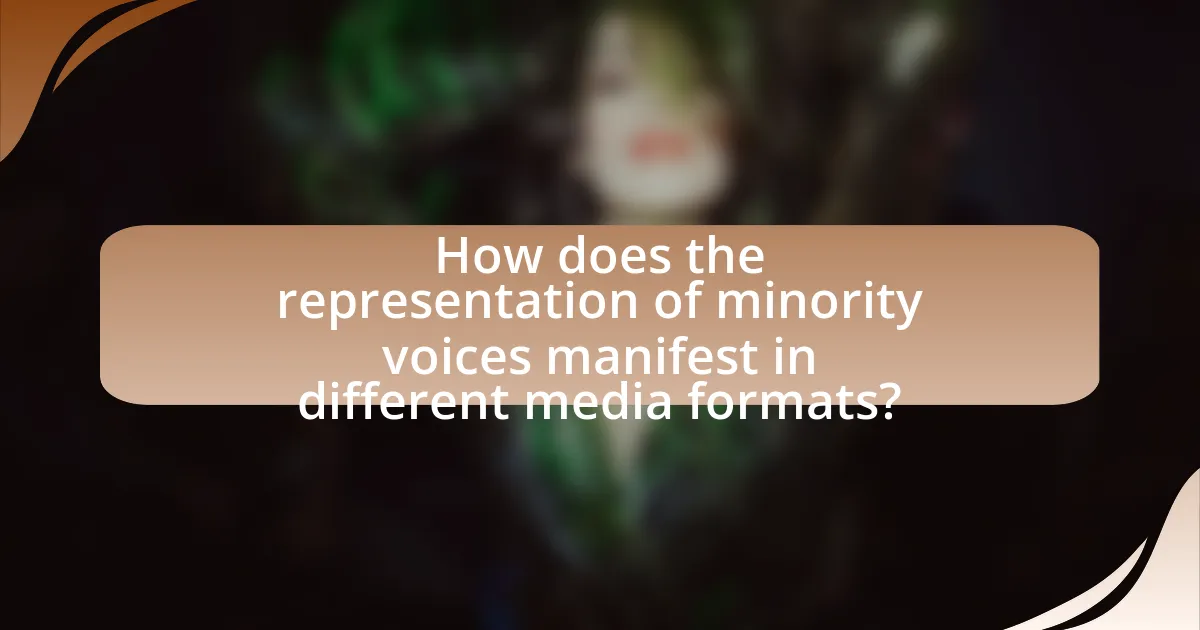
How does the representation of minority voices manifest in different media formats?
The representation of minority voices manifests in different media formats through diverse storytelling, character inclusion, and authentic narratives. In film, for instance, movies like “Black Panther” and “Crazy Rich Asians” showcase protagonists from underrepresented backgrounds, highlighting their cultures and experiences, which contributes to broader societal understanding. In television, series such as “Pose” and “Master of None” feature LGBTQ+ and immigrant narratives, respectively, allowing for nuanced portrayals that challenge stereotypes. Additionally, literature and digital media platforms, including podcasts and blogs, amplify minority perspectives by providing spaces for personal stories and discussions that might otherwise be overlooked. Research indicates that increased representation leads to greater empathy and social change, as seen in studies by the Geena Davis Institute on Gender in Media, which found that diverse representation positively impacts audience perceptions and attitudes.
What are the differences in representation across television, film, and print media?
Television, film, and print media differ significantly in their representation of minority voices, primarily due to their formats and audience engagement methods. Television often provides ongoing narratives that allow for deeper character development and complex storylines, which can lead to more nuanced portrayals of minority groups. For instance, shows like “Pose” and “Master of None” have been praised for their authentic representation of LGBTQ+ and immigrant experiences, respectively.
Film, on the other hand, typically relies on shorter narratives and visual storytelling, which can sometimes lead to stereotypical representations due to time constraints. However, films like “Moonlight” and “Black Panther” have successfully challenged these norms by presenting rich, multifaceted characters from minority backgrounds, earning critical acclaim and box office success.
Print media, including newspapers and magazines, often provides a platform for in-depth analysis and opinion pieces, allowing for a broader discussion of minority issues. However, representation can be limited by editorial choices and the demographics of the readership. Studies have shown that minority voices are often underrepresented in print journalism, with a 2018 report indicating that only 13% of newsroom staff identified as people of color.
In summary, while television allows for deeper character exploration, film can challenge stereotypes through impactful storytelling, and print media offers analytical depth but often lacks diverse representation.
How do storytelling techniques vary in representing minority voices?
Storytelling techniques vary in representing minority voices by employing diverse narrative structures, character development, and cultural contexts that reflect the unique experiences of these groups. For instance, first-person narratives often provide intimate insights into the lives of minority individuals, allowing for authentic representation of their struggles and triumphs. Additionally, the use of non-linear storytelling can highlight the complexities of identity and heritage, as seen in works like “The Brief Wondrous Life of Oscar Wao” by Junot Díaz, which interweaves personal and historical narratives to convey the immigrant experience. Furthermore, incorporating cultural symbols and language specific to minority communities enhances authenticity and fosters a deeper connection with the audience, as demonstrated in films like “Coco,” which celebrates Mexican culture through its storytelling. These techniques collectively contribute to a richer, more nuanced portrayal of minority voices in mainstream media.
What examples highlight successful representation in each format?
Successful representation of minority voices in mainstream media can be seen in various formats, including film, television, and literature. For instance, the film “Black Panther” showcases a predominantly Black cast and explores African culture, achieving both critical acclaim and box office success, grossing over $1.3 billion worldwide. In television, the series “Pose” features a significant number of transgender and LGBTQ+ actors, highlighting their stories and experiences, which has garnered multiple awards, including Emmy nominations. In literature, the novel “The Hate U Give” by Angie Thomas addresses issues of race and police violence, resonating with a wide audience and becoming a bestseller, with over 1 million copies sold. These examples illustrate how diverse representation can lead to both artistic success and cultural impact.
How do audience perceptions affect the representation of minority voices?
Audience perceptions significantly influence the representation of minority voices by shaping the narratives that media producers prioritize. When audiences hold stereotypes or biases, media outlets often cater to these perceptions to attract viewership, leading to a skewed portrayal of minority groups. For instance, a study by the Pew Research Center found that 61% of Americans believe that media representations of racial and ethnic minorities are often negative, which can result in media reinforcing these negative stereotypes rather than providing a balanced view. Consequently, the pressure to align with audience expectations can limit the diversity and complexity of minority narratives presented in mainstream media.
What role does audience feedback play in shaping media content?
Audience feedback plays a crucial role in shaping media content by providing creators with insights into viewer preferences and reactions. This feedback influences decisions on narrative direction, character development, and thematic focus, ensuring that content resonates with its audience. For instance, platforms like social media allow immediate audience reactions, which can lead to adjustments in ongoing series or future projects based on viewer engagement metrics. Research indicates that shows with high audience interaction often see increased ratings and longevity, demonstrating the tangible impact of audience input on media production.
How do demographics influence media consumption and representation?
Demographics significantly influence media consumption and representation by shaping the preferences, access, and portrayal of various groups in media. For instance, age demographics affect platform usage; younger audiences tend to favor streaming services and social media, while older demographics may prefer traditional television. Additionally, racial and ethnic demographics impact representation, as studies show that diverse audiences seek content that reflects their identities. According to a 2021 report by the Pew Research Center, 61% of Black Americans feel that media representation of their community is insufficient, highlighting the demand for more inclusive narratives. This disparity in representation can lead to skewed perceptions and reinforce stereotypes, further emphasizing the need for media that accurately reflects the demographic diversity of society.
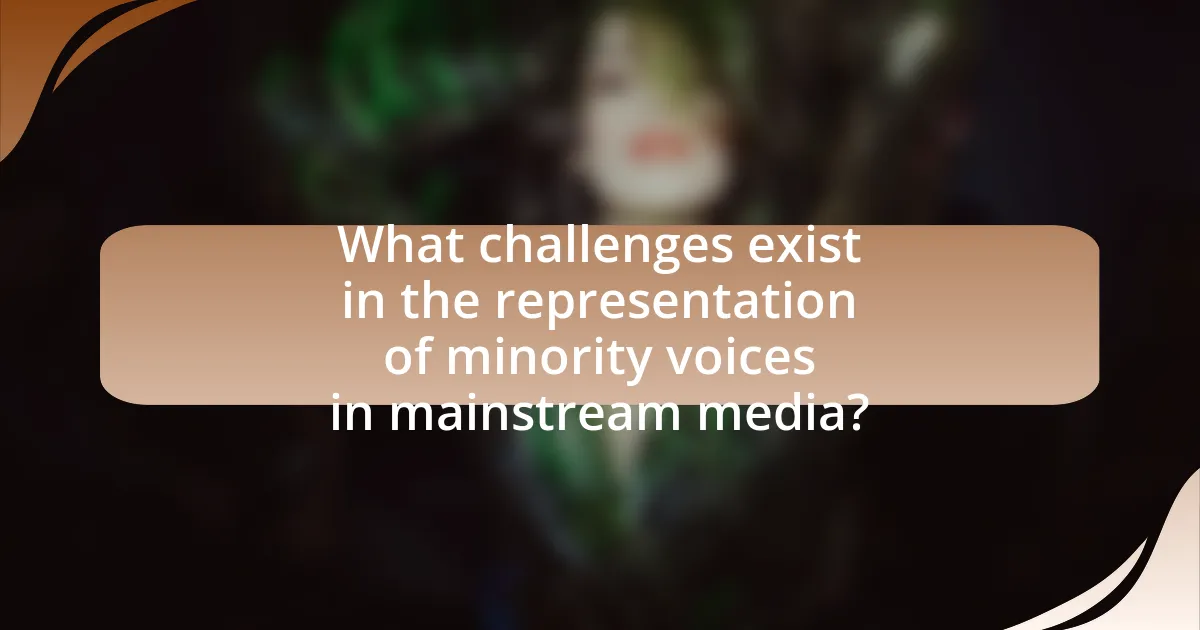
What challenges exist in the representation of minority voices in mainstream media?
The challenges in the representation of minority voices in mainstream media include underrepresentation, stereotyping, and lack of access to decision-making roles. Underrepresentation occurs when minority groups are not adequately reflected in media content, leading to a narrow portrayal of their experiences. For instance, a 2019 study by the Annenberg Inclusion Initiative found that only 28.3% of speaking characters in film were from underrepresented racial/ethnic groups. Stereotyping perpetuates harmful narratives, as minority characters are often confined to clichéd roles, which can distort public perception. Additionally, the lack of access to decision-making roles in media organizations limits the ability of minority voices to influence content creation, as evidenced by a 2020 report from the USC Annenberg School for Communication and Journalism, which highlighted that only 12% of film directors were women of color. These challenges collectively hinder authentic representation and contribute to the marginalization of minority perspectives in mainstream media.
What barriers do minority voices face in gaining representation?
Minority voices face significant barriers in gaining representation, primarily due to systemic discrimination, lack of access to resources, and underrepresentation in decision-making roles. Systemic discrimination manifests in biased hiring practices and limited opportunities for minority individuals in media organizations, which restricts their ability to influence narratives. Additionally, the lack of financial resources and support networks hampers minority creators from producing and distributing their work effectively. According to a 2021 report by the Annenberg Inclusion Initiative, only 5.3% of film directors were from underrepresented racial and ethnic groups, highlighting the stark underrepresentation in key creative positions. This combination of factors creates a cycle that perpetuates the marginalization of minority voices in mainstream media.
How do systemic issues within the media industry contribute to underrepresentation?
Systemic issues within the media industry contribute to underrepresentation by perpetuating biases in hiring practices, content creation, and distribution. These biases often result in a lack of diversity among decision-makers, which influences the narratives and perspectives that are prioritized in media coverage. For instance, a 2020 report by the Annenberg Inclusion Initiative found that only 16% of film directors were women, and even fewer were from underrepresented racial and ethnic groups, highlighting the disparity in representation at the highest levels of the industry. Additionally, systemic barriers such as limited access to funding and resources for minority creators further exacerbate the issue, leading to a media landscape that fails to reflect the diversity of the audience it serves.
What are the consequences of misrepresentation or lack of representation?
Misrepresentation or lack of representation can lead to significant social and cultural consequences, including the perpetuation of stereotypes and the marginalization of minority groups. When media fails to accurately portray diverse voices, it reinforces harmful narratives that can influence public perception and policy. For instance, studies have shown that consistent misrepresentation in media can contribute to systemic discrimination, as seen in the portrayal of racial minorities, which often skews public understanding and acceptance. Furthermore, a lack of representation can result in diminished self-esteem and identity issues among underrepresented groups, as they may feel invisible or devalued in society. This dynamic can hinder social cohesion and exacerbate divisions within communities, ultimately affecting societal progress and equality.
How can the media improve the representation of minority voices?
The media can improve the representation of minority voices by actively including diverse perspectives in content creation and decision-making processes. This can be achieved through hiring practices that prioritize diversity in staffing, ensuring that minority individuals are involved in storytelling, and creating platforms for underrepresented voices. Research indicates that diverse teams produce more innovative and relatable content, as seen in a study by McKinsey & Company, which found that companies with higher diversity levels are 35% more likely to outperform their peers in profitability. Additionally, media outlets can implement community engagement initiatives that solicit feedback from minority groups, ensuring their narratives are accurately portrayed and respected.
What strategies can be implemented to enhance diversity in media content?
To enhance diversity in media content, organizations can implement strategies such as inclusive hiring practices, diverse storytelling, and collaboration with minority creators. Inclusive hiring practices ensure that media teams reflect a variety of backgrounds, which can lead to more authentic representation. Diverse storytelling involves creating narratives that encompass different cultures, experiences, and perspectives, thereby enriching the content. Collaboration with minority creators allows for authentic voices to be heard and represented, fostering a more inclusive media landscape. Research by the Annenberg Inclusion Initiative found that films with diverse casts and crews tend to perform better at the box office, highlighting the commercial viability of diversity in media.
How can collaboration with minority communities improve representation?
Collaboration with minority communities can improve representation by ensuring that diverse perspectives and experiences are authentically included in media narratives. When media organizations engage with these communities, they gain insights that reflect the realities and values of underrepresented groups, leading to more accurate and relatable content. For instance, studies have shown that films and television shows featuring authentic minority voices tend to perform better in terms of audience engagement and critical acclaim, as seen with productions like “Black Panther,” which highlighted African culture and garnered significant box office success. This collaboration not only enriches storytelling but also fosters a sense of belonging and visibility for minority audiences, ultimately enhancing the overall quality and diversity of mainstream media.
What practical steps can individuals take to support minority representation in media?
Individuals can support minority representation in media by actively seeking out and promoting diverse content creators and stories. This can be achieved by following and sharing works from minority filmmakers, authors, and artists on social media platforms, thereby amplifying their voices. Additionally, individuals can advocate for inclusive hiring practices within media organizations by supporting initiatives that prioritize diversity in casting, writing, and production roles. Research indicates that diverse representation not only enriches storytelling but also reflects the demographics of audiences; for instance, a 2020 study by the USC Annenberg Inclusion Initiative found that films with diverse casts performed better at the box office. By engaging in these actions, individuals contribute to a media landscape that values and reflects minority perspectives.


